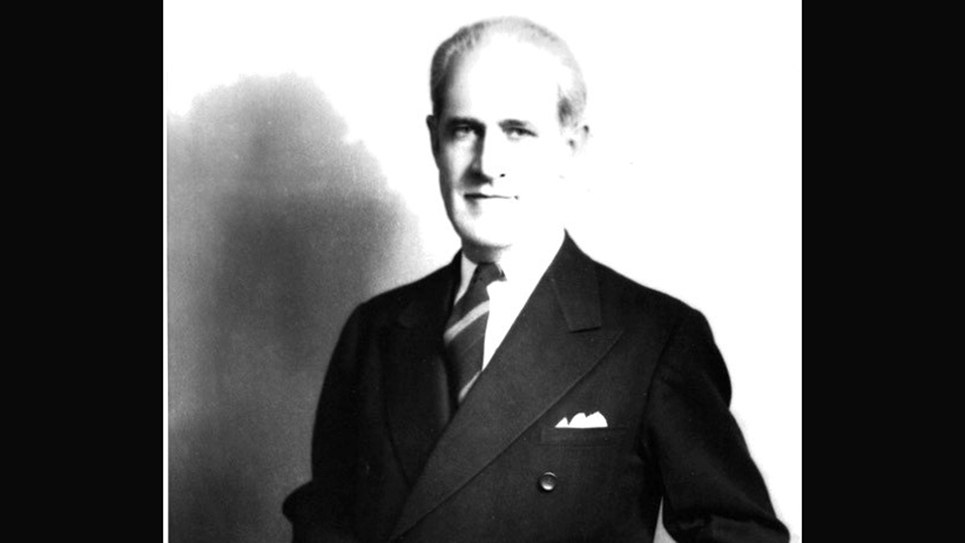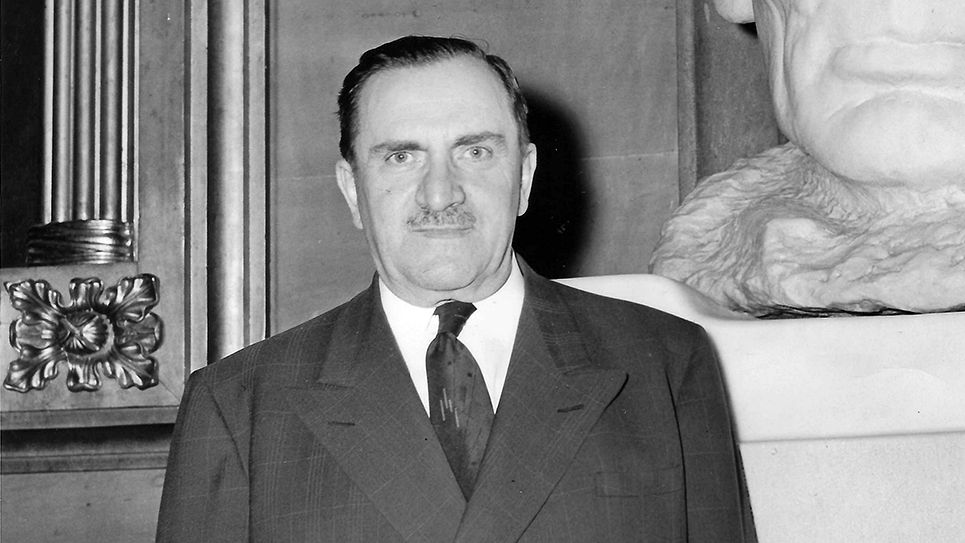Politician from the Prairie: Harlan Bushfield of South Dakota
Harlan John Bushfield served only a single term in the United States Senate, but he made quite an impression on his home state of South Dakota in a relatively short period of time. Bushfield rose from a printer’s devil to serve as his state’s governor and United States Senator.
Allen Drury, a best-selling author and journalist, recalled when covering the U.S. Senate as a young reporter for the Associated Press Bushfield strongly resembled Tennessee’s Andrew Jackson. Standing erect like General Jackson, Bushfield possessed a square jaw and was a commanding figure on the political platform. Trim and tall, Harlan J. Bushfield for a time was highly popular in South Dakota.
Bushfield was a dedicated Republican, a member of the conservative bloc in the Senate who had been labeled as an outright reactionary by the more liberal members of the news media of the day. Bushfield was considered to be a rugged individualist who had pursued a strict economy as governor of South Dakota.
Political opponents described Bushfield as “ruthless” and accused him of heading one of the strongest political machines ever seen in the Mount Rushmore State. Yet the genesis of Bushfield’s own political success came from his having been chairman of South Dakota’s state Republican party, where he organized down to the precinct level. Those same contacts served him well when he ran for public office, forming a statewide network he could tap into at election time. For all his attributes as a politician, Harland Bushfield was neither colorful nor a showman.
Those who knew Harland Bushfield described him as having a strong character and perhaps an equally strong personality. Governor George Mickelson thought his predecessor was a very frank person who never evaded questions. Congressman Francis Case recalled Bushfield never considered whether an issue was popular, but rather whether he thought it was the right course to follow.
Harland Bushfield was not the kind of man to be bullied. The South Dakota senator was one of those public figures who hurled the charge “liar” at muckraking columnist Drew Pearson when the Senate considered the nomination of Aubrey Williams to serve as administrator of the Rural Electrification Administration.
Bushfield had first come to high office as a proponent of economy in government as South Dakota, like every state in the nation, was doing its best to claw its way out of the deprivations, financial ruin and suffering of the Great Depression. While campaigning for governor in 1938, Bushfield pointed to the state’s rural credit debt as “South Dakota’s white elephant for a generation.” Once elected governor, Harlan Bushfield was not fearful of bragging about his accomplishments. Speaking before South Dakota’s state legislature, Governor Bushfield told legislators, “We have done the most outstanding job of reorganization and liquidation ever accomplished by any state in the union.”
One of the hallmarks of Bushfield’s reorganization of state government was eliminating duplication of services and moving most special funds into the general fund so that the legislature could make direct appropriations. Before Harlan Bushfield had taken office, South Dakota had a deficit; when he left office in 1943, the state treasury had a surplus of $4 million.
Nor did Bushfield shy away from a fight. While governor, Harlan Bushfield engaged in a bitter struggle with legislators who supported a homestead tax exemption and succeeded in restoring the state’s retail sales tax to 2%. That same tax had been 3% during the years South Dakota had suffered through a serious drought and other revenue had dried up with the water. The state’s economy was buoyed by the Second World War with farm prices soaring and retail purchases likewise rising. Critics were astonished that in spite of Bushfield’s tax cuts, the state treasury remained filled. That certainly did nothing to diminish Bushfield’s popularity in South Dakota.
Governor Bushfield took his desire to cut taxes and drive for economy in government with him to the United States Senate where he became a persistent critic of big government spending. Bushfield’s last message as governor to South Dakota’s state legislature decried “stupendous federal taxes,” which he predicted “will bring disaster to many and will lay a burden upon everyone which will bow their backs in endless toil to liquidate it.” Prior to leaving the state capitol in Pierre, Governor Bushfield had once again asked the legislature to repeal the net income tax, which it did in the 1943 session.
As Governor Harlan Bushfield left Pierre for Washington, D.C., the newly elected senator took with him a fierce opposition to the notion of government bureaus issuing regulations and/or orders which had the effect of law. Bushfield steadfastly believed only Congress had the power to make laws. In one of the South Dakota senator’s first exchanges with Capitol Hill reporters, Bushfield said, “I feel that the bureaucrats so freely making regulations on this and that affecting the daily lives of the American people should get off the pavement around Washington and get about the country where people really live.”
An attorney by vocation, Bushfield’s first attempts at seeking elected office did not portend a successful political career, much less one that would take him to the highest offices within the gift of his people. Bushfield failed in his attempt to win the state attorney general’s office in 1918 when he lost the Republican primary. In 1923, Bushfield presided over the South Dakota Republican state convention. Bushfield announced as a candidate for a seat on the South Dakota State Supreme Court but later withdrew.
Bushfield’s rise to power began with the death of Charles S. McDonald, chairman of the South Dakota Republican Party. McDonald was killed in a car crash in 1934 and Bushfield was elected to succeed him in October 1935. Like much of the rest of the country, the Great Depression had been a boon to the Democratic Party in South Dakota. Tom Berry had been elected governor in 1932 and was reelected in 1934. William J. Bulow had been elected to the United States Senate in 1930 and reelected in 1936. When GOP U.S. Senator Peter Norbeck died on December 20, 1936, Governor Berry appointed fellow Democrat Herbert Hitchcock to serve until the next regular election.
With Bushfield as GOP state chairman, Republican fortunes began to improve almost immediately. Republican gubernatorial candidate Leslie Jensen defeated Tom Berry, who was seeking a third term. Jensen did not seek reelection as governor in 1938, but rather ran for the GOP nomination for the United States Senate. Tom Berry ran against and defeated his own appointee in the Democratic primary for the U.S. Senate. Jensen lost the Republican primary to businessman Chan Gurney. With Jensen running for the Senate, Bushfield became a candidate for governor.
The pendulum swung back toward the Republicans in South Dakota in 1938 with both Harlan Bushfield and Chan Gurney winning the general election. Bushfield was reelected to a second two-year term as governor in 1940 and became a candidate for the United States Senate in 1942. The incumbent, William J. Bulow, was one of the most conservative Democrats in the Senate and had been opposed to most of the New Deal. Bulow, himself a former governor, was past seventy and his failure to support the Roosevelt administration was a huge political liability amongst South Dakota Democrats. Former Governor Tom Berry was running for the Senate yet again and thrashed Bulow in the Democratic primary; Senator Bulow failed to win even 30% of the votes cast.
Facing the best vote-getter South Dakota Democrats could possibly nominate for the U.S. Senate, Bushfield campaigned as an unabashed Republican and reiterated his fiscal conservatism as he campaigned across the state. Speaking in Yankton at his campaign opener in October of 1942, Bushfield told his audience it was “necessary for the people to select public officials who will do that job efficiently and intelligently and not as rubber stamps or play boys.” Bushfield reminded South Dakotans his gubernatorial service had benefitted the public and boasted of his accomplishments as governor. “I have restored the credit of our state so that it is no longer listed as the blackest spot in the nation. I have restored the confidence of our people in the strength and fertility and the dependability of South Dakota. I have helped to restore the faith and confidence and the interest of the people of other states in our own state.”
Bushfield pointed to his success in reorganizing state government to make it more efficient and emphasized the honesty and economy of his administration. “We have eliminated waste, reduced the payroll, reduced taxes, and lowered the cost of running the government 20 per cent. . .” Governor Bushfield also made certain voters remembered his having put the state government into the black with the largest balance in South Dakota’s history. Bushfield noted he had been able to “aid the common schools” while at the same time “lightened the farmer’s tax burden.”
Nor did Harlan Bushfield ignore the biggest concern of Americans during 1942; the governor said the single most important issue was winning the war. Yet Tom Berry begged to differ, if only slightly. “Of course everybody is for that,” Berry drawled, “because nobody in this country wants to be Hitler’s slave.”
“An even bigger issue is the winning of the peace afterward,” Berry said, “against politicians such as Bushfield. Our soldiers won the other war (World War I) and ten United States senators prevented a peace that would end war, as was promised the soldiers.”
Berry noted it took two-thirds of the U. S. Senate to approve a peace treaty, which the former governor believed would help to avert a third world war. “In 1919, 37 senators voted against the peace treaty,” Berry thundered, “just six more than one-third of those voting. Those six are responsible for the war today.”
Tom Berry said he wasn’t at all surprised Bushfield had brought Ohio U.S. Senator Robert A. Taft into South Dakota to campaign on his behalf. Referring to Taft as “the multimillionaire senator” who Berry claimed was “an outspoken opponent” of peace. Berry said that whoever the people of South Dakota elected would vote on any peace treaty following the conclusion of the Second World War in the Senate. “I am everlastingly in favor of stopping these world wars, but Governor Bushfield doesn’t think enough of the babies of today to say that the big issue is to provide that they shall not be fighting in another world war when they become young men.”
“As for the winning of the war, if Bushfield should do no more as senator than he has as governor, we won’t get very far,” Berry scoffed.
The people of South Dakota disagreed and Harlan Bushfield beat Tom Berry easily in the general election.
Much of Bushfield’s time in the Senate was compromised by his increasing high blood pressure. For the last two years of his six years in the Senate, Harlan Bushfield had trouble controlling his high blood pressure. That was much more of an issue then than it is now. Bushfield apparently had five serious episodes or strokes from July 1945 until he died in office. Initially, Senator Bushfield had announced he would seek reelection to a second term in 1948, but announced in January of that year he would retire due to his failing health. Bushfield’s pronouncement was due to yet another stroke. The sixty-six-year-old senator was in a hospital in Miller, South Dakota when he suffered a fatal cerebral hemorrhage on September 27, 1948.
Senator Bushfield was succeeded in office, at least for the interim, by his wife, Vera, who was highly popular with South Dakotans in her own right. When Governor George Mickelson appointed Mrs. Bushfield, the Senate was not then in session. Rather than go to Washington, Mrs. Bushfield contented herself with remaining in Pierre with a small staff where she concentrated on helping constituents with their problems. Vera Bushfield outlived her husband by almost thirty years.







